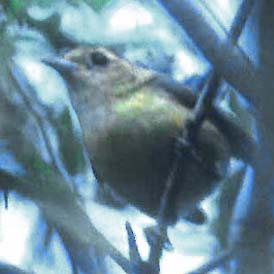
a web page by Don Roberson |
 |
CARDINALS, GROSBEAKS & ALLIES |
|||
|
|||
In addition to the migratory headliners from temperate latitudes, there are plenty of cardinalids in the Neotropics. One example is Yellow Grosbeak (above). Indeed, quite a number of this family are big-billed to deal with heavy fruit and seeds, although there are a wide variety of bill sizes and shapes within this family. |
|||
|
|||
One should not be misled by the family name Cardinalidae. There are various "cardinals" in South America, in the genus Paroaria, that are not in this family but are actually tanagers (e.g., Red-capped Cardinal). While some birds in this family bear the English name "cardinal," or "bunting," or "grosbeak," these names are no longer helpful in figuring out what family the bird fits in. The Cardinalidae now includes some birds called "tanagers," like Summer Tanager (right). Genetic evidence has shaken up the applecart for sure, but my plea is to avoid wholesale English name changes in the quest for the "perfect" names. |
|||
 |
|||
Among the (mostly) arid-loving species in this family are the buntings in the genus Passerina (Blue Grosbeak, above, is also in the genus). The males are truly spectacular while females are about as dull and inconspicuous as a bird can get. These shots — both by Greg Lasley — show a male Painted Bunting (below left) and a singing male Varied Bunting (below right). These, plus Lazuli and Indigo P. cyanea, are found locally in the southern U.S., but two additional and beautiful species are endemic to Mexico: Rose-bellied P. rositae and Orange-breasted P. leclancherii. |
|||
|
|||
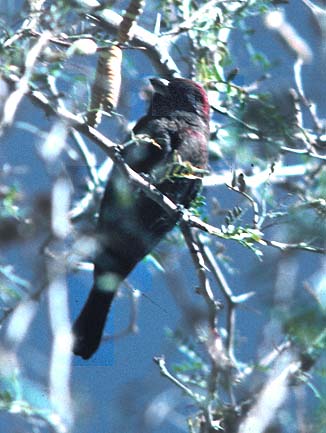 When
seen in the sun, Varied Bunting has a subtle but overwhelming mix of
velvet purple, lavender blue, and crimson. When seen in the shade or
backlit, it is a little blackish blah bird. The transformation can be
remarkable. At this writing (in 2009) there are only three accepted
records from California, and only one in recent history — a male at
Mesquite Springs in Death Valley 18–21 Nov 1977. I was personally
involved with that occurrence. Donna Dittmann and I had driven all the
way from the San Francisco Bay area to Death Valley in hopes of seeing
a stake-out Streak-backed Oriole. We missed it. We stopped at Mesquite
Springs on the way home and Donna was the first to spot the Varied Bunting.
I grabbed my camera and took a series of shots (one of them, right) to
document this incredible vagrant. We got on the 'grapevine' from the
nearest pay phone (this was long before BirdBoxes, cell phones, or the
Internet) and alerted the State's birding community. That find remains
among the highlights of my personal birding career in California. When
seen in the sun, Varied Bunting has a subtle but overwhelming mix of
velvet purple, lavender blue, and crimson. When seen in the shade or
backlit, it is a little blackish blah bird. The transformation can be
remarkable. At this writing (in 2009) there are only three accepted
records from California, and only one in recent history — a male at
Mesquite Springs in Death Valley 18–21 Nov 1977. I was personally
involved with that occurrence. Donna Dittmann and I had driven all the
way from the San Francisco Bay area to Death Valley in hopes of seeing
a stake-out Streak-backed Oriole. We missed it. We stopped at Mesquite
Springs on the way home and Donna was the first to spot the Varied Bunting.
I grabbed my camera and took a series of shots (one of them, right) to
document this incredible vagrant. We got on the 'grapevine' from the
nearest pay phone (this was long before BirdBoxes, cell phones, or the
Internet) and alerted the State's birding community. That find remains
among the highlights of my personal birding career in California. |
|||
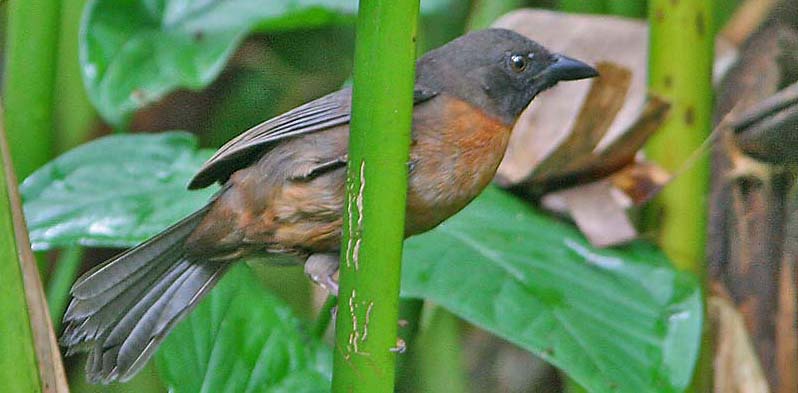 |
|||
There are the well-known North American grosbeaks in the genus Pheucticus [Rose-breasted, Black-headed P. melancephalus] but also another four species in Central or South America [including Yellow Grosbeak, shown at the top of this page]. Other tropical birds known as "grosbeaks" include birds in the genera Caryothraustes and Cyanocompsa. The latter includes Blue-black Grosbeak (left), a wide-ranging lowland bird from Mexico to Brazil. |
|||
Another surprise in the genetic evidence was that the three Amaurospiza seedeaters are cardinalids. This includes Blue Seedeater A. concolor, a montane bamboo specialist ranging from southern Mexico to Ecuador, and the newly-described Carrizal Seedeater A. carrizalensis (Lentino & Restall (2003). |
|||
|
|||
| It will take some time to get used to all this re-arrangement in the Cardinalidae, as it will with the revisions in the true tanagers [Thraupidae]. It is hard to generalize about this group right now. We are still awaiting the full final parameters of these families. | |||
Photos: The Yellow Grosbeak Pheucticus chrysopeplus was at El Triunfo, Chiapas, Mexico, on 20 Mar 2002. The male Rose-breasted Grosbeak Pheucticus ludovicianus was a vagrant in my back yard in Pacific Grove, California, USA, on 29 July 2007. Greg W. Lasley photographed the male Northern Cardinal Cardinalis cardinalis in Starr County, Texas, USA, on 30 July 1995. John Sorensen took the male Lazuli Bunting Passerina amoena near Salinas, Monterey County, California, in May 2001. The male Western Tanager Piranga ludoviciana was in my Pacific Grove, California, backyard in May 2003. The male Summer Tanager Piranga rubra was at Morongo Valley, California, on 28 May 2004. The male Blue Grosbeak Passerina caerulea was near Borrego Springs, California, on 13 Apr 2006. The female Pyrrhuloxia Cardinalis sinuatus was in Chemehuevi Wash, San Bernardino Co., California, on 29 May 1995. Greg W. Lasley photographed the male Painted Bunting Passerina ciris in Starr County, Texas, on 30 July 1995, and Greg captured the singing male Varied Bunting Passerina versicolor near Ozona, Crockett Co., Texas, on 1 June 2001. My own shot of the vagrant Varied Bunting was at Mesquite Springs, Death Valley Nat'l Monument (now Nat'l Park) on 18 Nov 1997. The Black-cheeked Ant-Tanager Habia atrimaxillaris was at Rio Tigre, Osa Peninsula, Costa Rica, on 25 Dec 2007; the Blue-black Grosbeak Cyanocompsa cyanoides was nearby, along the Rio Rincon, Costa Rica, on 27 Dec 2007. Greg Lasley photographed the singing Dickcissel Spiza americana in Travis Co., Texas, in Apr 1995. The female Red-breasted Chat Granatellus venustus was at Concordia, Sinaloa, Mexico, on 24 Feb 1987. All photos © Don Roberson, except those credited © John Sorensen and © Greg W. Lasley, and used with permission; all rights reserved. Both John & Greg have superb web sites; use the links on their names. Bibliographic essay
Literature cited:
|
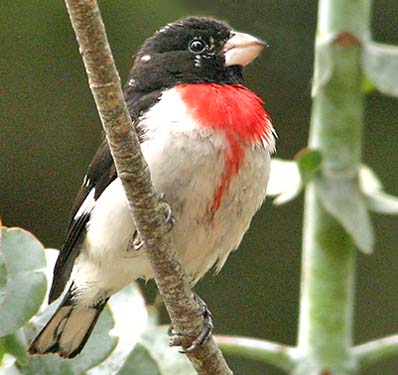 Birders
in North America are used to thinking about the Cardinalidae as the
family with cardinals, grosbeaks, and buntings. This includes some of
the most gorgeous plumages that we encounter, birds like Rose-breasted Grosbeak (left), Northern Cardinal (below left © Greg W. Lasley), and Lazuli Bunting
(below center © John Sorensen). Now, with the publications of the
2009 AOU Supplement, another set of lovely birds are added to this
family — the Piranga tanagers, including Western Tanager (below right). Genetic evidence had been piling up for a decade that the Piranga
tanagers — which also include Scarlet P. olivacea, Summer P. rubra, and
Hepatic Tanager P. flava — were not related to the colorful but
non-migratory tanagers of the Neotropics [
Birders
in North America are used to thinking about the Cardinalidae as the
family with cardinals, grosbeaks, and buntings. This includes some of
the most gorgeous plumages that we encounter, birds like Rose-breasted Grosbeak (left), Northern Cardinal (below left © Greg W. Lasley), and Lazuli Bunting
(below center © John Sorensen). Now, with the publications of the
2009 AOU Supplement, another set of lovely birds are added to this
family — the Piranga tanagers, including Western Tanager (below right). Genetic evidence had been piling up for a decade that the Piranga
tanagers — which also include Scarlet P. olivacea, Summer P. rubra, and
Hepatic Tanager P. flava — were not related to the colorful but
non-migratory tanagers of the Neotropics [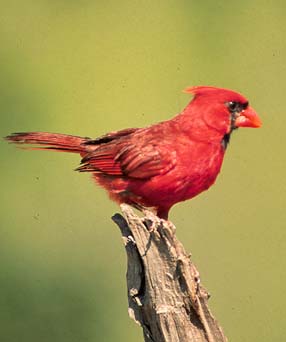
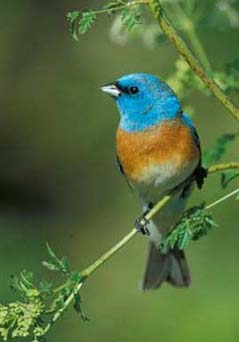
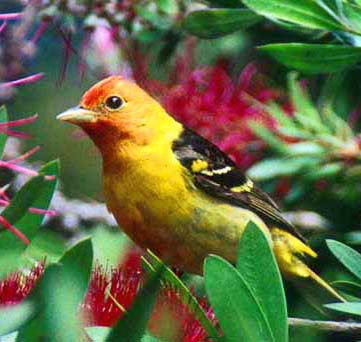
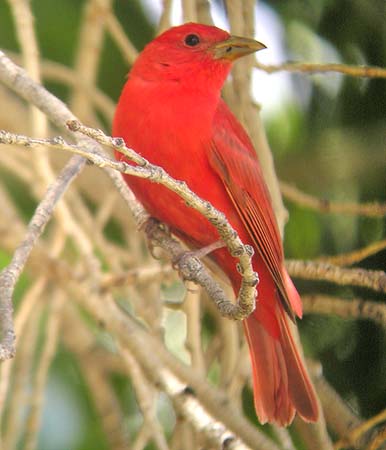 The
genetic evidence is impressive: e.g., Bledsoe (1998), Yuri &
Mindell (2002), Klicka et al. (2000,
2007). Workers in the past had paid too much attention to bill shape,
and not enough to biology, and convergent evolution masked many
relationships. This group is treated as a family, following AOU (1998),
which defined the group on the basis of shared characters of the skull
to consist of such genera as Caryothraustes, Cyanocompsa, Passerina, Pheucticus, Cardinalis, Saltator, and Spiza. Klicka et al. (2000, 2007) failed to find genetic support for inclusion of Saltator
in this family, and their genetic data showed that the Cardinalidae, as
it had been defined, was highly polyphyletic. The saltators (genus Saltator)
have been removed, although where they go is less certain. The current
(2009) thinking is that a monophyletic Cardinalidae requires the
addition of the Piranga tanagers, the Amaurospiza seedeaters, and the Granatellus chats.
The
genetic evidence is impressive: e.g., Bledsoe (1998), Yuri &
Mindell (2002), Klicka et al. (2000,
2007). Workers in the past had paid too much attention to bill shape,
and not enough to biology, and convergent evolution masked many
relationships. This group is treated as a family, following AOU (1998),
which defined the group on the basis of shared characters of the skull
to consist of such genera as Caryothraustes, Cyanocompsa, Passerina, Pheucticus, Cardinalis, Saltator, and Spiza. Klicka et al. (2000, 2007) failed to find genetic support for inclusion of Saltator
in this family, and their genetic data showed that the Cardinalidae, as
it had been defined, was highly polyphyletic. The saltators (genus Saltator)
have been removed, although where they go is less certain. The current
(2009) thinking is that a monophyletic Cardinalidae requires the
addition of the Piranga tanagers, the Amaurospiza seedeaters, and the Granatellus chats.
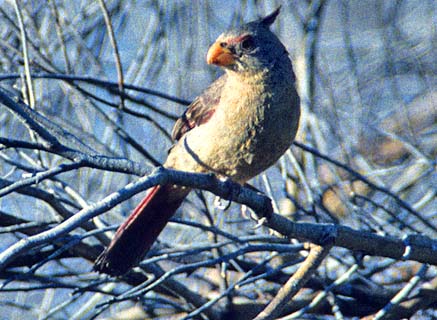 A fair number of the Cardinalidae are adopted to arid climates, including Blue Grosbeak (above) that prefers riparian edges and Pyrrhuloxia
(left), which is a feature in the mesquite and cactus landscape of the
American southwest. This particular Pyrrhuloxia was a vagrant to
California. Rita and I drove to the southwest corner of California to
chase a male that had been reported, and we located not only it, but 3
different singing males and this female. She was building a nest for
only the second breeding effort for the State.
A fair number of the Cardinalidae are adopted to arid climates, including Blue Grosbeak (above) that prefers riparian edges and Pyrrhuloxia
(left), which is a feature in the mesquite and cactus landscape of the
American southwest. This particular Pyrrhuloxia was a vagrant to
California. Rita and I drove to the southwest corner of California to
chase a male that had been reported, and we located not only it, but 3
different singing males and this female. She was building a nest for
only the second breeding effort for the State. 
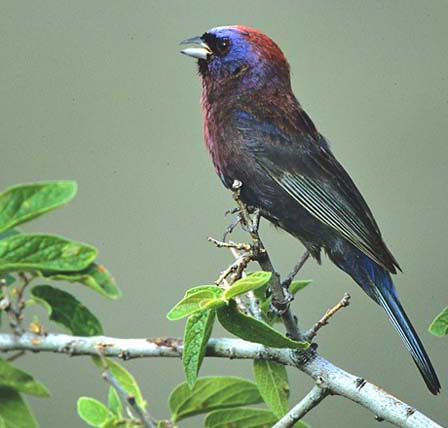
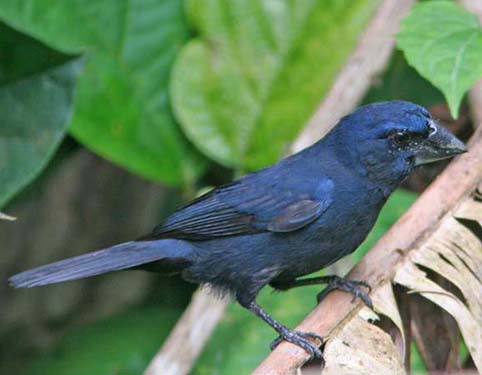 The Cardinalidae does include a number of genera that inhabit the Neotropics. Ant-tanagers of the genus Habia are one of these. There are five species of ant-tanager, ranging from such widespread birds as Red-crowned Ant-Tanager H. rubica (ranges from Mexico to Brazil) to endemics such as Black-checked Ant-Tanager
(above). It is confined to the undergrowth of thick lowland forest on
the Osa Peninsula of Costa Rica. Three Chrolorthraupis tanagers also
belong in this family (Klicka et al. 2000, 2007).
The Cardinalidae does include a number of genera that inhabit the Neotropics. Ant-tanagers of the genus Habia are one of these. There are five species of ant-tanager, ranging from such widespread birds as Red-crowned Ant-Tanager H. rubica (ranges from Mexico to Brazil) to endemics such as Black-checked Ant-Tanager
(above). It is confined to the undergrowth of thick lowland forest on
the Osa Peninsula of Costa Rica. Three Chrolorthraupis tanagers also
belong in this family (Klicka et al. 2000, 2007).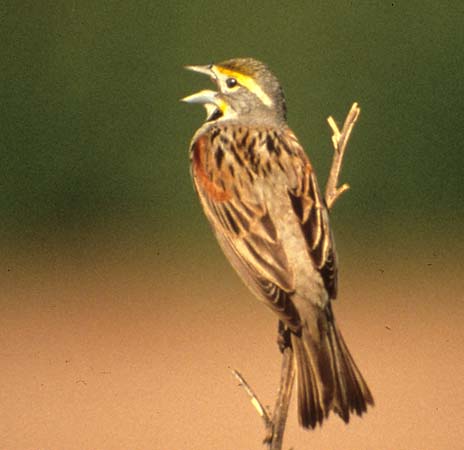 The unique Dickcissel (right, singing male © Greg W. Lasley) remains a member of this family but new additions include the three
chats in the genus Granatellus. An example is Red-breasted Chat of
western Mexico (female; below). For many years these were included
among the North American warblers (Parulidae) but it was often
considered a poor fit there.
The unique Dickcissel (right, singing male © Greg W. Lasley) remains a member of this family but new additions include the three
chats in the genus Granatellus. An example is Red-breasted Chat of
western Mexico (female; below). For many years these were included
among the North American warblers (Parulidae) but it was often
considered a poor fit there.